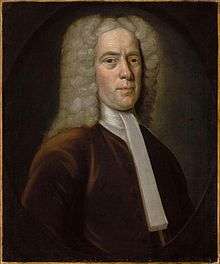Edmund Quincy (1681–1737)
| Edmund Quincy III | |
|---|---|
 1737 portrait by John Smibert | |
| Born |
14 Oct 1681 Braintree, Massachusetts |
| Died |
23 Feb 1737 London, England |
| Cause of death | Smallpox |
| Resting place | Burnhill Fields Burial Grounds, London, England |
| Residence | Boston, Massachusetts, Braintree, Massachusetts |
| Education | Harvard University 1699 |
| Occupation | Merchant, Judge |
| Home town | Braintree, Massachusetts |
| Title | Judge, Colonel, Commissioner |
| Spouse(s) | Dorothy Flynt (1678-1737) |
| Children | Edmund IV, Esther, Elizabeth, Dorothy, Josiah I, Esther, Mary |
| Parent(s) | Edmund Quincy (1628–1698) and Elizabeth Goodkin (1645-1700) |
Edmund Quincy (/ˈkwɪnzi/; 1681–1737) III was the son of Edmund Quincy (1627-1698) II and his second wife, Elizabeth Gookin. He married Dorothy Flynt and had 7 children. Four lived to adulthood, including Edmund Quincy IV, Col. Josiah_Quincy_I (1710-1784) and Dorothy Quincy, who was the topic of a famous poem by Oliver Wendell Holmes, Sr.[1][2]
Life
Like his father and grandfather, he was deeply involved with the affairs of the Massachusetts colony. He was a magistrate, Supreme Court judge from 1718 until his death, and a colonel in the Massachusetts militia. In 1737, he was appointed to a commission to settle the boundary between Massachusetts and New Hampshire,[3] and traveled to London on this matter with his son Josiah Quincy I. However, he contracted smallpox and died before his return to Massachusetts. The colony built a monument at his grave in Brunhill Fields Burial Ground in London and gave 1,000 acres (4.0 km2) in Lenox to his family as a tribute for all of his efforts.
Notes and references
- ↑ "Genealogical and Personal Memoirs Relating to the Families of Boston and Eastern Massachusetts, Vol II", by William Richard Cutter, Lewis Historical Publishing Co., New York (1908), pp. 592-598.
- ↑ Crawford, Mary Caroline (1902). The Romance of Old New England Rooftrees. L. C. Page & Company. p. 117. Retrieved 2008-03-17.
- ↑ "Genealogical and Personal Memoirs," Cutter, p. 593
|